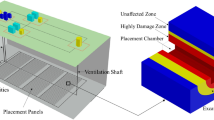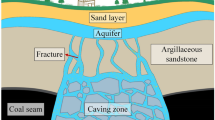Abstract
The present work involves a comprehensive experimental study of porosity and pore size distribution of sedimentary rocks, from oil fields formations, by means of two electromagnetic techniques, namely proton (1H) nuclear magnetic resonance (NMR) and dielectric complex constant (DCC) as function of the frequency, both providing complementary results. The NMR yields an accurate determination of the relative pore size distribution and both movable and irreducible fluids. The DCC measurement provides the direct current electrical resistivity of the samples with different degrees of hydration. Thus, combining the results of both techniques allows the determination of the tortuosity index, by means of Archie’s relation, and from it the average pore channel length. These measurements are performed on fully hydrated (saturated), centrifuged, dried, and cleaned rocks and also on samples with the irreducible fluids. Finally, the results are complemented with capillary pressure measurements to obtain the total volume associated with the pore channels related to the rock permeability. Additionally, the work presents a particular method to use a network analyzer to measure the DCC.














Similar content being viewed by others
References
A. Abragam, The Principles of Nuclear Magnetism (Oxford University Press, New York, 1961)
M. Mehring, Principles of High Resolution NMR in Solids (Springer, Berlin, 1983)
M.A. Chesta, M.E. Ramia, S. Jeandrevin, C.A. Martín, Appl. Phys. A 97, 301–307 (2009)
R.G. Coates, L. Xiao, M.G. Prammer, NMR Logging, Principles and Applications (Halliburton Energy Services, Houston, 1999)
C.A. Martín, M.E. Ramia, L. Barberis. J. Soc. Pet. Eng. SPE-107781-PP (2007)
R.L. Kleinberg, W.E. Kenyon, P.P. Mitra, J. Magn. Reson. A 108(2), 206 (1994)
C.P. Slichter, Principles of Magnetic Resonance (Springer, Berlin, 1990)
A.M. Niell, C.A. Martín, M.E. Ramia, Ann. Magn. Reson. 7, 1–44 (2008)
N. Bona, E. Rossi, S. Capaccioli, Soc. Pet. Eng. 69741, 80 (2000)
K.S. Cole, R.H. Cole, J. Chem. Phys. 9, 341–351 (1941)
M.E. Ramia, C.A. Martín y M.A. Chesta, Trabajos de Física, UNC—FAMAF, No 14, www.famaf.unc.edu.ar, (2012)
C.A. Martín, G.A. Monti, J. Comput. Phys. 75, 244 (1998)
L.A. Spaletti, I. Queralt, S.D. Matheos, F. Colombo, J. Maggi, J. South Am. Earth Sci. 25(4), 440 (2008)
T. Djebar, E.C. Donaldson, Petrophysics (Elsevier, Amsterdam, 2004)
P.C. Lysne, Geophysics 48, 775 (1983)
N. Bona, E. Rossi, S. Capaccioli, Proc. Soc. Core Anal. 9925, 1 (1999)
Acknowledgments
We thank to Dr. R. Astini from the Geology Department of the Facultad de Ciencias Exactas Físicas y Naturales for his help in sample preparation. This research has been supported Secyt-Universidad Nacional de Córdoba.
Author information
Authors and Affiliations
Corresponding author
Rights and permissions
About this article
Cite this article
Ramia, M.E., Martín, C.A. Sedimentary rock porosity studied by electromagnetic techniques: nuclear magnetic resonance and dielectric permittivity. Appl. Phys. A 118, 769–777 (2015). https://doi.org/10.1007/s00339-014-8798-0
Received:
Accepted:
Published:
Issue Date:
DOI: https://doi.org/10.1007/s00339-014-8798-0




